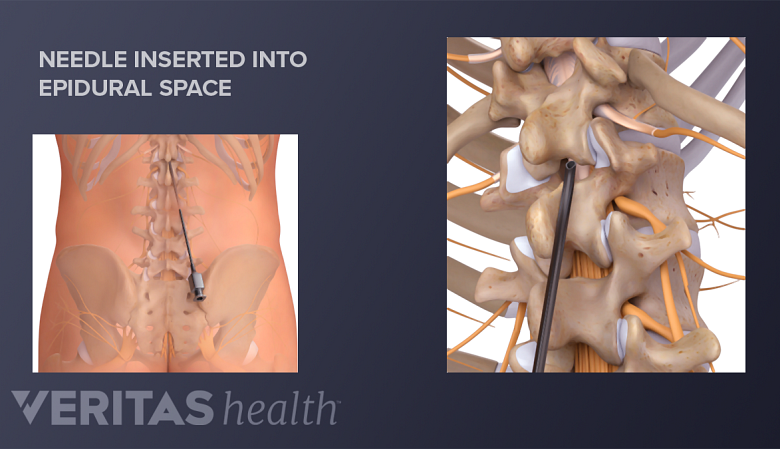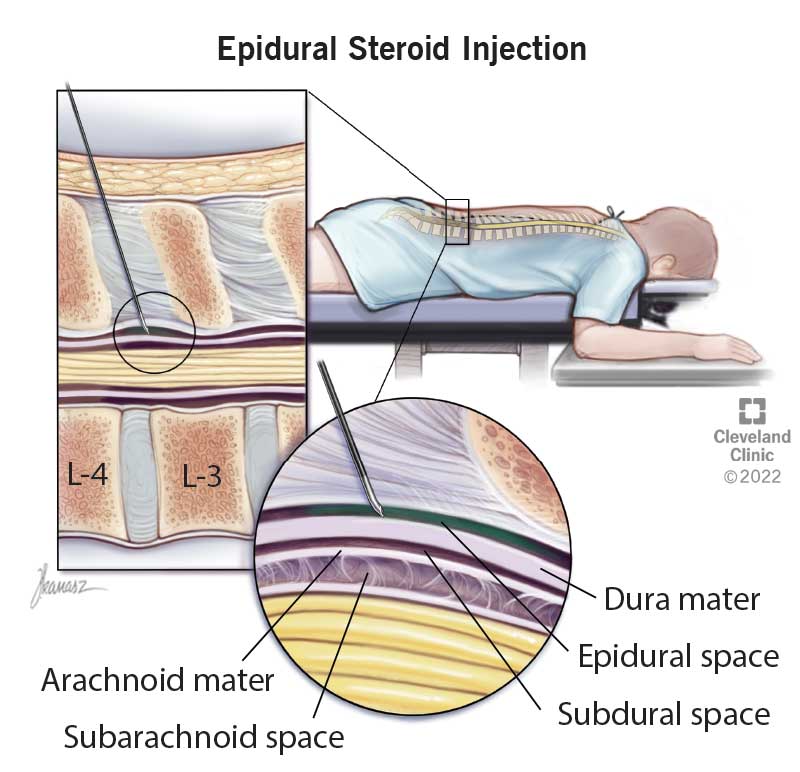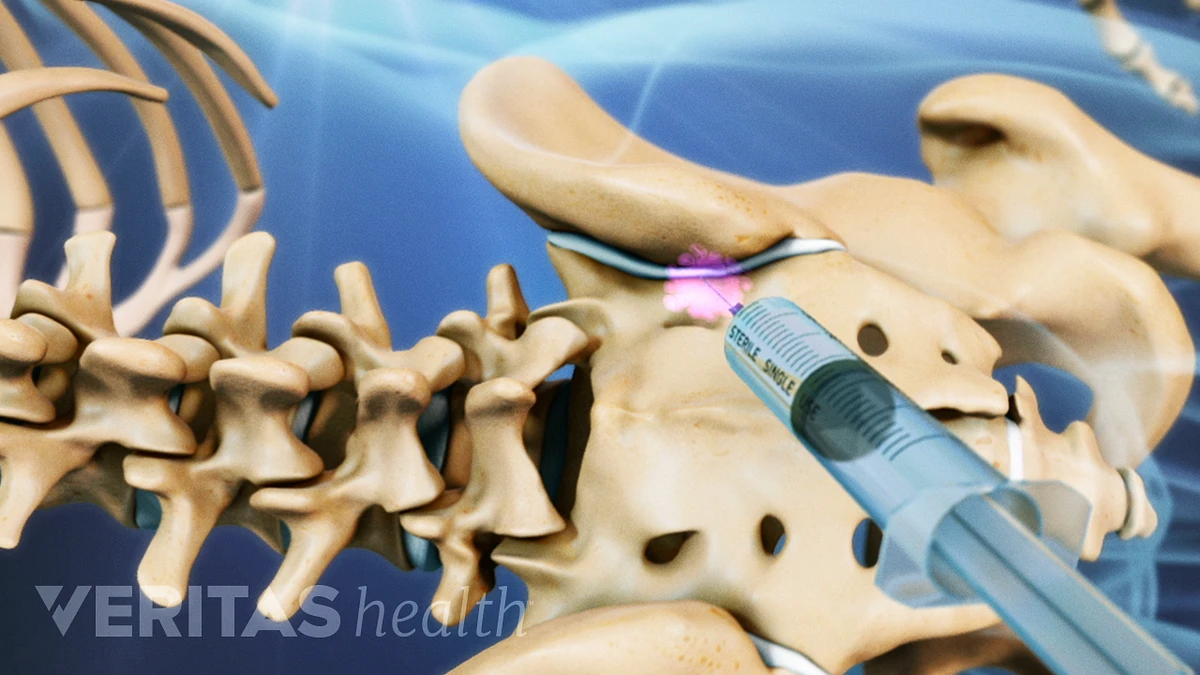A Bilateral Transforaminal Epidural Steroid Injection (TESI) is a minimally invasive procedure used to relieve spinal pain and Inflammation. It involves injecting corticosteroids into the epidural space to help reduce pain and Inflammation in the spine and surrounding areas.
TESI is a safe and effective treatment for various spinal conditions, such as herniated discs, spinal stenosis, and degenerative disc disease. It can help to reduce pain, stiffness, and swelling and help to improve mobility and quality of life. If you are experiencing spinal pain or discomfort, a TESI may be a suitable treatment option.
Please speak to your doctor or healthcare provider to learn more about this procedure and whether it suits you.

Credit: www.spine-health.com
Benefits Of Bilateral Transforaminal Epidural Steroid Injection
Bilateral Transforaminal Epidural Steroid Injection offers several benefits, including reducing Inflammation, alleviating spinal pain, and easing radiating pain from the spine to other body areas. This non-surgical treatment is considered safe for managing lumbar spinal stenosis and is a preferred option for many patients in Austin, Texas, and beyond.
Benefits of Bilateral Transforaminal Epidural Steroid Injection When it comes to managing back pain, the Bilateral Transforaminal Epidural Steroid Injection (BTESI) is a highly effective and minimally invasive procedure that delivers anti-inflammatory medication directly to the affected nerve roots in the spine. This treatment is usually recommended for patients suffering from lower back pain caused by herniated discs, spinal stenosis, or sciatica. Reduced Inflammation BTESI can significantly relieve pain and minimize Inflammation in the affected area. The injection is administered to the affected nerve roots, and the medication is spread into the epidural space to create a widespread anti-inflammatory effect. This targeted delivery method allows patients to experience prompt relief, as the medication is directly delivered to the inflamed region. Pain Relief The steroid medication used in BTESI provides long-term pain relief. The medication is a potent anti-inflammatory agent that reduces swelling and pain around the inflamed nerve. Within one to two days of the injection, patients typically start to experience substantial pain relief. The procedure can be repeated as needed, usually 1-2 times yearly. Improvement in Range of Motion In addition to pain relief and reduced Inflammation, BTESI can also help improve the range of motion in the affected area. For patients experiencing chronic pain, the procedure can help restore mobility by decreasing the Inflammation causing the discomfort. This improvement in mobility can also reduce the likelihood of future injury and help restore quality of life. Overall, BTESI is an effective and minimally invasive procedure that can significantly relieve patients experiencing lower back pain. It works by reducing Inflammation, providing long-term pain relief, and improving the range of motion in the affected area. If you are considering this procedure, consult your doctor to determine if BTESI is right.

Credit: my.clevelandclinic.org
How Is The Procedure Done?
During a Bilateral Transforaminal Epidural Steroid Injection (TESI), a thin needle is used to inject steroid medication into the epidural space near the affected nerve roots. This can help reduce pain and Inflammation in the spine and other areas of the body that may be affected by radicular problems like sciatica.
You your neck or back down to your arms or legs. This procedure is a minimally invasive technique used to treat spinal conditions such as herniated discs, spinal stenosis, and degenerative disc disease. In this blog post, we will explore the details of the Bilateral Transforaminal Epidural Steroid Injection procedure, including preparation, the procedure itself, and post-procedure care.
Preparation
Before the procedure, the patient must provide their complete medical history to ensure the injection is safe. The doctor will thoroughly examine the patient’s vital signs and identify any signs of infection or other health issues. The patient will also be given instructions on what to do before the procedure, such as fasting for a certain period.
The Procedure
During the procedure, the patient lies down on their stomach while a local anaesthetic is applied to the injection site. The doctor then inserts a thin needle under the guidance of an X-ray machine or fluoroscope into the epidural space on both sides of the spine. This area is located above the spinal cord and below the spinal bones. Once the needle is in place, the doctor injects a steroid medication to reduce the Inflammation and pain in the area. The procedure usually takes less than 30 minutes, and the patient can generally go home the same day. However, it is highly recommended that patients arrange a ride home as they may experience numbness or weakness in their legs lasting several hours after the injection.
Post-procedure Care
After the injection, the patient will be observed briefly to ensure no complications. The doctor will give patients detailed instructions on what to do after the procedure, such as avoiding strenuous activity for a period. The patient may also be advised to use ice and heat therapy to reduce pain and swelling in the area. In conclusion, the Bilateral Transforaminal Epidural Steroid Injection is a minimally invasive procedure used to treat spinal conditions like a herniated disc or spinal stenosis. The procedure is safe and usually takes less than 30 minutes. However, following the pre and post-procedure care instructions is crucial to avoid complications and maximize the benefits.
Risks And Side Effects
Possible SEO-friendly response: During a bilateral transforaminal epidural steroid injection, a healthcare provider injects a corticosteroid medication into both spinal nerve openings on each side of the spine. This procedure can help reduce Inflammation and pain in the back, legs, or arms caused by conditions like herniated discs, spinal stenosis, or sciatica.
However, like any medical intervention, there are potential risks and side effects associated with this injection, such as numbness, weakness, dizziness, headache, or infection. It is essential to discuss your situation with your doctor and follow their instructions for post-operative care.
Pine down to your arms or legs. However, like all medical procedures, there are risks and side effects associated with this treatment. It’s important to understand these potential risks and side effects before deciding to undergo a bilateral transforaminal epidural steroid injection. In this post, we’ll take a closer look at this procedure’s risks and side effects, including the possibility of infection, bleeding, allergic reactions, and nerve damage.
Infection
One of the risks associated with the bilateral transforaminal epidural steroid injection is the possibility of infection. While the risk of infection is low, taking precautions to minimize your risk is still essential. Your doctor will likely recommend avoiding swimming, bathing, or using hot tubs for some time after your injection. Additionally, it’s necessary to keep the injection site clean and dry to reduce the risk of infection. Contact your doctor immediately if you experience any signs of infection, such as redness, swelling, or discharge around the injection site.
Bleeding
Another potential risk of this procedure is bleeding. While most patients won’t experience any significant bleeding, it is possible. Patients who are taking blood-thinning medication may be at a higher risk of bleeding during the procedure. Your doctor will likely advise you to stop taking any blood-thinning medication for a specified amount of time before the injection. If you experience any signs of bleeding, such as increased bruising or swelling, contact your doctor right away.
Allergic Reaction
Some patients may experience an allergic reaction to the medication used during the injection. Allergic reactions can range from mild to severe, so you must notify your doctor if you notice any symptoms, such as itching, rash, or difficulty breathing. Your doctor will monitor you for a short period following the injection to ensure you don’t experience any adverse reactions.
Nerve Damage
While rare, nerve damage is another potential risk associated with a bilateral transforaminal epidural steroid injection. Nerve damage can result in weakness, numbness, or tingling in the affected limb. Your doctor will take every precaution to minimize your risk of nerve injury during the injection. It’s important to discuss any concerns you have about nerve damage with your doctor before undergoing the procedure. In conclusion, understanding the risks and side effects of a bilateral transforaminal epidural steroid injection is crucial in making an informed decision about whether this procedure is correct for you. While most patients experience only minor discomfort, knowing the potential risks is essential. Discussing these risks with your doctor can help determine if this treatment is best for your condition.

Credit: www.spine-health.com
Frequently Asked Questions On Bilateral Transforaminal Epidural Steroid Injection
What Is The Recovery Time For Transforaminal Epidural Steroid Injection?
Recovery time for a transforaminal epidural steroid injection varies, but most people can resume normal activities within 24 hours. Some patients may experience mild soreness or numbness that usually subsides after a few days. Possible side effects include numbness or weakness in the legs or feet, headache, and dizziness.
It is a safe procedure offering non-surgical treatment of lumbar spinal stenosis, and the injection can alleviate spinal pain and Inflammation.
How Painful Is A Transforaminal Epidural Steroid Injection?
A transforaminal epidural steroid injection may cause some discomfort. Still, we do numb the skin and deeper tissues with a local anaesthetic using a skinny needle before inserting the spinal needle. Once numbed, placing the spinal needle often feels like more of an intense pressure and pinching than a sharp pain.
What Is The Difference Between A Transforaminal Epidural And A Lumbar Epidural?
A lumbar epidural steroid injection addresses lower limb and pelvic pain. In contrast, a transforaminal epidural steroid injection offers pain management for radicular problems on one side of the spine, targeting the neck, thoracic, and lumbar regions. The difference lies in their specific target areas.
What Are The Side Effects Of A Transforaminal Epidural Injection?
The side effects of a transforaminal epidural injection may include numbness or weakness in the legs or feet, dizziness, and headache. However, it is generally a safe and non-surgical treatment for spinal pain and Inflammation. The procedure involves injecting corticosteroids into the epidural space near the source of the Inflammation to reduce pain and Inflammation.
Conclusion
If you are experiencing spinal pain and Inflammation or radiating pain from your spine, a bilateral transforaminal epidural steroid injection can be a safe and effective non-surgical treatment option. With corticosteroids, Inflammation can be reduced, and pain can be eased.
It is essential to consult with a qualified healthcare provider to determine if this procedure suits your needs. Take action and seek treatment for a better quality of life.



